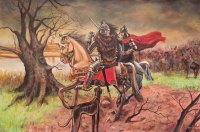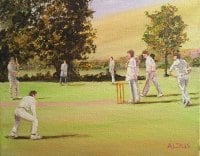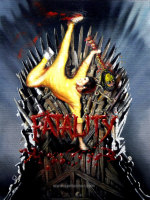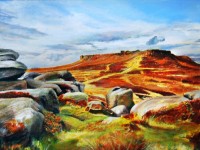Top Level > Original Paintings (6101) / Sculptures > Leon Goodman
"Scucca" by Leon Goodman (now sold 8/1/12)

BEAUTIFUL ORIGINAL OIL PAINTING ON CANVAS "Scucca". This beautiful painting capturing the East Anglian legendary black dog or scucca!! Tales tell of a large black hellhound with malevolent flaming eyes (or a single eye) that is red!! Sightings of the hound range in size from a normal dog to the size of a horse!!
The legends of Black Shuck roaming the Anglian countryside date back to the time of the Vikings. It is told that the Vikings talked of this hellish beast that stalked the misty fens!!

The name Scucca comes from the Anglo-Saxon word scucca meaning “demon”, or possibly from the local dialect word shucky meaning “shaggy” or “hairy”. The legend may have been part of the inspiration for the Sherlock Holmes novel The Hound of the Baskervilles.
Sometimes Black Shuck is referred to as the Doom Dog. It is said that his appearance bodes ill to the beholder, although not always. More often than not, stories tell of Black Shuck terrifying his victims, but leaving them alone to continue living normal lives. In some cases it has supposedly happened before close relatives to the observer die or become ill.
Sometimes Black Shuck has appeared headless, and at other times he appears to float on a carpet of mist. According to folklore, the spectre often haunts graveyards, sideroads, crossroads and dark forests. Black Shuck is also said to haunt the coast road between West Runton and Overstrand.
One of the most notable reports of Black Shuck is of his appearance at the churches of Bungay and Blythburgh in Suffolk. On 4 August 1577, at Blythburgh, Black Shuck is said to have burst in through the church doors. He ran up the nave, past a large congregation, killing a man and boy and causing the church tower to collapse through the roof. As the dog left, he left scorch marks on the north door which can be seen at the church to this day.
The encounter on the same day at Bungay was described in “A Straunge and Terrible Wunder” by the Reverend Abraham Fleming in 1577:
“ This black dog, or the divel in such a linenesse (God hee knoweth al who worketh all,) runing all along down the body of the church with great swiftnesse, and incredible haste, among the people, in a visible fourm and shape, passed between two persons, as they were kneeling uppon their knees, and occupied in prayer as it seemed, wrung the necks of them bothe at one instant clene backward, in somuch that even at a mome[n]t where they kneeled, they stra[n]gely dyed. ”
Other accounts attribute the event to lightning or the Devil. The scorch marks on the door are referred to by the locals as “the devil’s fingerprints”, and the event is remembered in this verse:
“ All down the church in midst of fire, the hellish monster flew, and, passing onward to the quire, he many people slew. ”
......BY THE SUPERB LEON GOODMAN WHO IS AN ACCOMPLISHED ARTIST HAVING BEEN A FINALIST AT THE GARRICK-MILNE PRIZE. HE HAS MANY OF HIS WORKS SOLD AT CHRISTIES. Measurements height 20 inches by 16 inches Oil on Canvas .............Box Framed
Wikipedia leon goodman leon-goodman.com
Leon Goodman has been a professional artist for the majority of his working life. His work has been sold at The Omell Gallery, Ascot, as well as Christies, the fine art auction house in London. Many of his works have sold to the U.S for thousands of pounds. (Please check out www.leon-goodman.com ) Since seeing his work, Risborough Art Gallery have made him a regularly featured artist. Leon’s philosophy is that it is not the delineation of the subject which is important, but its fragmentation. He believes a strictly photographic image does not allow the viewer to participate in the painting. If the image is fragmented, the viewer can imagine for himself the missing parts and involve himself in the creation of the whole image. The viewer has seen his own interpretation of the fragmented images; the next viewer may see something different.100% GOLD POWERSELLER.

















































